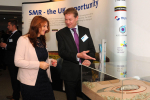
Trudy has responded to a ‘call for evidence’ consultation into the potential of High Temperature Gas Reactors (HTGRs).
In her response, Trudy supports the Government’s preference to explore the potential of HTGRs, and makes the case for Copeland being a suitable location for the technology.
A full outline of the consultation can be found at:
Trudy's full response is below:
- Do you agree with the government’s preference to explore the potential of high temperature gas reactors (HTGRs) to meet the key objective of the Programme?
A: Yes
- Whether there is any new, additional evidence on other AMR technologies that could meet the key objective of the Programme?
A: No
- How the capability of the UK supply chain could support the Programme?
A: As the Member of Parliament for Copeland, I know that Copeland has the necessary capability within the supply-chain to support this programme.
In Copeland, we proudly call ourselves the home of nuclear excellence, we are the place where the world’s first civil nuclear power station was connected to the grid. Since then, we have been able to grow and harness world-leading nuclear skills. Now, as we look forward, we have the qualities to lead the way on clean energy generation.
Copeland knows more about nuclear power than anywhere else in Europe. We have a deep talent pool with a track record of safety and delivering nationally significant projects. This is evidenced with our nuclear workforce of 27,000, we are home to 31% of the entire UK Nuclear workforce (Copeland Borough Council, 2020). Moreover, we have continuously managed the decommissioning of the world’s most hazardous site, Sellafield. The expertise we hold in nuclear safety is second to none.
The strength of the nuclear industry in Copeland was most recently highlighted by an Oxford Economics Study, which showed that the nuclear industry and its respective supply-chain was responsible for 58.7% of all employment in Copeland, and 59.4% of total GVA (Oxford Economics, 2017). This shows the strength of the industry locally, the supply-chain is diverse and multi-faceted, we are home to expertise across the nuclear sector.
The Oxford Economics study showed that Sellafield Ltd spent £1.2bn in supply-chain spending in 2016/17 (Oxford Economics, 2017, p.11), 99% of this spending was within the UK. This again shows the strength of the supply-chain locally, but also nationally, as Sellafield was able to procure nearly all its contracts and resources from within the UK. Business within the Copeland area were home for 50.7% of this spend, showing the strength of the local supply-chain.
We are also home to many organisations with nuclear expertise, both public, private, and academic. The National Nuclear Laboratory are based in West Cumbria, as are the University of Manchester’s Dalton Facility. They use their base in West Cumbria to undertake world-leading research in this sector, again evidence for the pool of talent that we are home to. It makes sense with our nuclear expertise, to co-locate on projects such as a High Temperature Gas Reactor and maximise on the output of this skilled workforce.
Moreover, a host of local bodies, such as the LEP and local councils have recently launched the Industrial Solutions Hub (ISH). ISH acknowledges the dominance of Sellafield Ltd in supply-chain procurement and seeks to leverage their economic power to diversify the supply-chain throughout West Cumbria. With ISH, a new campus and innovation hub will be launched to bring together public and private organisations, as well as academia. This will be to help with diversification, with the end goal of making the supply-chain more flexible, enabling the export of services from West Cumbria. This will enable the supply-chain to adapt to new challenges within the industry, such as facilitating this programme.
Furthermore, in Copeland there is the social need for a programme of this calibre. Copeland ranks 85th out of 317 lower tier authorities for the Deprivation of Index, placing it in the most deprived third of the country (rank of average score) (Cumbria Observatory, 2020). We are an area of vast industrial heritage, but a lack of inward investment. On that point, Copeland is somewhere exactly fit for the Government’s ‘levelling-up’ agenda; we have the necessary infrastructure, and with the right investment we can thrive.
Finally, a High Temperature Gas Reactor would also have alignment with the Cumbria Nuclear Prospectus and the local council’s vision for Copeland, as laid out in Copeland 2040. The vision laid out in Copeland 2040 has a clean energy park situated in West Cumbria, with nuclear at its core. It would drive Clean Growth as we head towards Net Zero by 2050.
West Cumbria is the place to do new, first of a kind, nationally significant nuclear missions – utilising the infrastructure we have; from skills to safety, and maximising the benefit of High Temperature Gas Reactors to Cumbria and UK plc.


